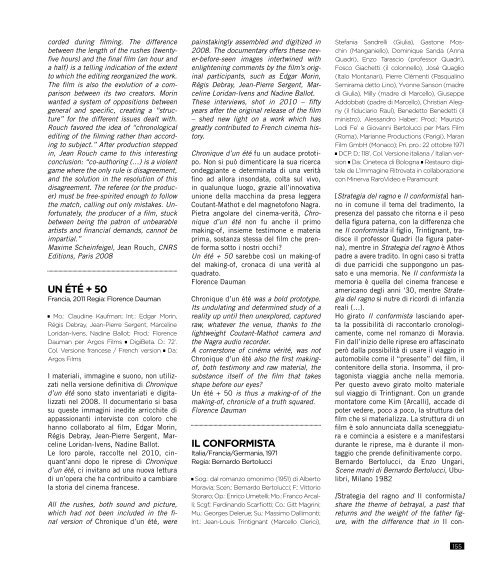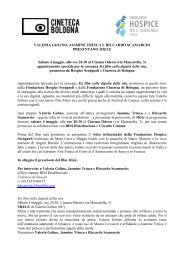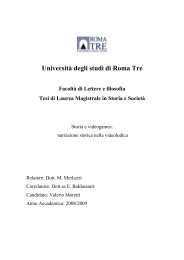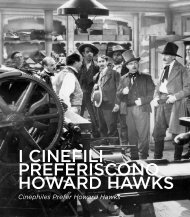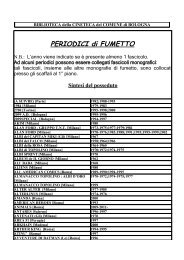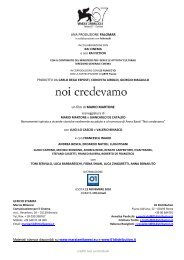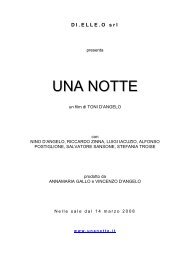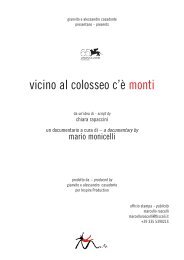Ritrovati & Restaurati sonori.pdf - Cineteca di Bologna
Ritrovati & Restaurati sonori.pdf - Cineteca di Bologna
Ritrovati & Restaurati sonori.pdf - Cineteca di Bologna
Create successful ePaper yourself
Turn your PDF publications into a flip-book with our unique Google optimized e-Paper software.
corded during filming. The <strong>di</strong>fference<br />
between the length of the rushes (twentyfive<br />
hours) and the final film (an hour and<br />
a half) is a telling in<strong>di</strong>cation of the extent<br />
to which the e<strong>di</strong>ting reorganized the work.<br />
The film is also the evolution of a comparison<br />
between its two creators. Morin<br />
wanted a system of oppositions between<br />
general and specific, creating a “structure”<br />
for the <strong>di</strong>fferent issues dealt with.<br />
Rouch favored the idea of “chronological<br />
e<strong>di</strong>ting of the filming rather than accor<strong>di</strong>ng<br />
to subject.” After production stepped<br />
in, Jean Rouch came to this interesting<br />
conclusion: “co-authoring (…) is a violent<br />
game where the only rule is <strong>di</strong>sagreement,<br />
and the solution in the resolution of this<br />
<strong>di</strong>sagreement. The referee (or the producer)<br />
must be free-spirited enough to follow<br />
the match, calling out only mistakes. Unfortunately,<br />
the producer of a film, stuck<br />
between being the patron of unbearable<br />
artists and financial demands, cannot be<br />
impartial.”<br />
Maxime Scheinfeigel, Jean Rouch, CNRS<br />
E<strong>di</strong>tions, Paris 2008<br />
UN ÉTÉ + 50<br />
Francia, 2011 Regia: Florence Dauman<br />
█ Mo.: Clau<strong>di</strong>ne Kaufman; Int.: Edgar Morin,<br />
Régis Debray, Jean-Pierre Sergent, Marceline<br />
Loridan-Ivens, Na<strong>di</strong>ne Ballot; Prod.: Florence<br />
Dauman per Argos Films █ DigiBeta. D.: 72’.<br />
Col. Versione francese / French version █ Da:<br />
Argos Films<br />
I materiali, immagine e suono, non utilizzati<br />
nella versione definitiva <strong>di</strong> Chronique<br />
d’un été sono stato inventariati e <strong>di</strong>gitalizzati<br />
nel 2008. Il documentario si basa<br />
su queste immagini ine<strong>di</strong>te arricchite <strong>di</strong><br />
appassionanti interviste con coloro che<br />
hanno collaborato al film, Edgar Morin,<br />
Régis Debray, Jean-Pierre Sergent, Marceline<br />
Loridan-Ivens, Na<strong>di</strong>ne Ballot.<br />
Le loro parole, raccolte nel 2010, cinquant’anni<br />
dopo le riprese <strong>di</strong> Chronique<br />
d’un été, ci invitano ad una nuova lettura<br />
<strong>di</strong> un’opera che ha contribuito a cambiare<br />
la storia del cinema francese.<br />
All the rushes, both sound and picture,<br />
which had not been included in the final<br />
version of Chronique d’un été, were<br />
painstakingly assembled and <strong>di</strong>gitized in<br />
2008. The documentary offers these never-before-seen<br />
images intertwined with<br />
enlightening comments by the film’s original<br />
participants, such as Edgar Morin,<br />
Régis Debray, Jean-Pierre Sergent, Marceline<br />
Loridan-Ivens and Na<strong>di</strong>ne Ballot.<br />
These interviews, shot in 2010 – fifty<br />
years after the original release of the film<br />
– shed new light on a work which has<br />
greatly contributed to French cinema history.<br />
Chronique d’un été fu un audace prototipo.<br />
Non si può <strong>di</strong>menticare la sua ricerca<br />
ondeggiante e determinata <strong>di</strong> una verità<br />
fino ad allora insondata, colta sul vivo,<br />
in qualunque luogo, grazie all’innovativa<br />
unione della macchina da presa leggera<br />
Coutant-Mathot e del magnetofono Nagra.<br />
Pietra angolare del cinema-verità, Chronique<br />
d’un été non fu anche il primo<br />
making-of, insieme testimone e materia<br />
prima, sostanza stessa del film che prende<br />
forma sotto i nostri occhi?<br />
Un été + 50 sarebbe così un making-of<br />
del making-of, cronaca <strong>di</strong> una verità al<br />
quadrato.<br />
Florence Dauman<br />
Chronique d’un été was a bold prototype.<br />
Its undulating and determined study of a<br />
reality up until then unexplored, captured<br />
raw, whatever the venue, thanks to the<br />
lightweight Coutant-Mathot camera and<br />
the Nagra au<strong>di</strong>o recorder.<br />
A cornerstone of cinéma vérité, was not<br />
Chronique d’un été also the first makingof,<br />
both testimony and raw material, the<br />
substance itself of the film that takes<br />
shape before our eyes?<br />
Un été + 50 is thus a making-of of the<br />
making-of, chronicle of a truth squared.<br />
Florence Dauman<br />
IL CONFORMISTA<br />
Italia/Francia/Germania, 1971<br />
Regia: Bernardo Bertolucci<br />
█ Sog.: dal romanzo omonimo (1951) <strong>di</strong> Alberto<br />
Moravia; Scen.: Bernardo Bertolucci; F.: Vittorio<br />
Storaro; Op.: Enrico Umetelli; Mo.: Franco Arcalli;<br />
Scgf.: Fer<strong>di</strong>nando Scarfiotti; Co.: Gitt Magrini;<br />
Mu.: Georges Delerue; Su.: Massimo Dallimonti;<br />
Int.: Jean-Louis Trintignant (Marcello Clerici),<br />
Stefania Sandrelli (Giulia), Gastone Moschin<br />
(Manganiello), Dominique Sanda (Anna<br />
Quadri), Enzo Tarascio (professor Quadri),<br />
Fosco Giachetti (il colonnello), José Quaglio<br />
(Italo Montanari), Pierre Clémenti (Pasqualino<br />
Semirama detto Lino), Yvonne Sanson (madre<br />
<strong>di</strong> Giulia), Milly (madre <strong>di</strong> Marcello), Giuseppe<br />
Addobbati (padre <strong>di</strong> Marcello), Christian Alegny<br />
(il fiduciario Raul), Benedetto Benedetti (il<br />
ministro), Alessandro Haber; Prod.: Maurizio<br />
Lo<strong>di</strong> Fe’ e Giovanni Bertolucci per Mars Film<br />
(Roma), Marianne Productions (Parigi), Maran<br />
Film GmbH (Monaco); Pri. pro.: 22 ottobre 1971<br />
█ DCP. D.: 118’. Col. Versione italiana / Italian version<br />
█ Da: <strong>Cineteca</strong> <strong>di</strong> <strong>Bologna</strong> █ Restauro <strong>di</strong>gitale<br />
de L’Immagine Ritrovata in collaborazione<br />
con Minerva RaroVideo e Paramount<br />
[Strategia del ragno e Il conformista] hanno<br />
in comune il tema del tra<strong>di</strong>mento, la<br />
presenza del passato che ritorna e il peso<br />
della figura paterna, con la <strong>di</strong>fferenza che<br />
ne Il conformista il figlio, Trintignant, tra<strong>di</strong>sce<br />
il professor Quadri (la figura paterna),<br />
mentre in Strategia del ragno è Athos<br />
padre a avere tra<strong>di</strong>to. In ogni caso si tratta<br />
<strong>di</strong> due parrici<strong>di</strong> che suppongono un passato<br />
e una memoria. Ne Il conformista la<br />
memoria è quella del cinema francese e<br />
americano degli anni ‘30, mentre Strategia<br />
del ragno si nutre <strong>di</strong> ricor<strong>di</strong> <strong>di</strong> infanzia<br />
reali (…).<br />
Ho girato Il conformista lasciando aperta<br />
la possibilità <strong>di</strong> raccontarlo cronologicamente,<br />
come nel romanzo <strong>di</strong> Moravia.<br />
Fin dall’inizio delle riprese ero affascinato<br />
però dalla possibilità <strong>di</strong> usare il viaggio in<br />
automobile come il “presente” del film, il<br />
contenitore della storia. Insomma, il protagonista<br />
viaggia anche nella memoria.<br />
Per questo avevo girato molto materiale<br />
sul viaggio <strong>di</strong> Trintignant. Con un grande<br />
montatore come Kim [Arcalli], accade <strong>di</strong><br />
poter vedere, poco a poco, la struttura del<br />
film che si materializza. La struttura <strong>di</strong> un<br />
film è solo annunciata dalla sceneggiatura<br />
e comincia a esistere e a manifestarsi<br />
durante le riprese, ma è durante il montaggio<br />
che prende definitivamente corpo.<br />
Bernardo Bertolucci, da Enzo Ungari,<br />
Scene madri <strong>di</strong> Bernardo Bertolucci, Ubulibri,<br />
Milano 1982<br />
[Strategia del ragno and Il conformista]<br />
share the theme of betrayal, a past that<br />
returns and the weight of the father figure,<br />
with the <strong>di</strong>fference that in Il con-<br />
155


